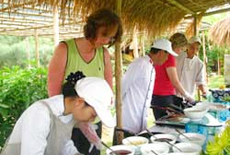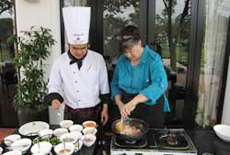American pottery artisan Lee Middleman and his wife Donnie decided to spice up their holiday to Viet Nam by joining a cooking class at La Residence Hotel&Spa in the former royal capital city of Hue. It proved to be an unforgettable experience.
 |
|
Taking a hand: Foreigners join a cooking class at Golden Sand Resort in Hoi An. |
"Offering cookery classes to foreign visitors is an excellent idea," Middleman told Viet Nam News via email.
"We really appreciated the dishes they introduced us to. It was a joy watching the way the food was prepared, and then later tasting it."
Lee and his wife were taught how to make Hue-style spring rolls. Part of the delight was visiting the local food market to buy vegetables, fruits and fish prior to the cooking class, he said.
The hotel's chef Nguyen Dong Hai said tourists were encouraged to visit the local market, which he said added to the fun.
"We encourage tourists to go to Dong Ba Market to buy ingredients with us," Hai said. "There they get the chance to rub shoulders with the locals, even haggle."
If however they haven't time, they can just take part in the cooking class at Le Parfum Restaurant, which looks over the romantic Huong River.
Hai said students were typically taught how to make nem trang (local spring rolls), com sen (steamed rice with lotus seeds), ca kho to (southern-style fish stew) and che (sweetened porridge).
Hai said the hotel's cookery classes were most popular with Australian tourists, who were fascinated by the way the dishes were decorated and by the strong flavours of Hue-style food.
Cookery classes are popular up and down the country. Shiokawa Makoto, 25, is among thousands of young Japanese tourists who have visited Viet Nam aboard the Peace Ship. As soon as he landed in Da Nang's Tien Sa Port, he and some friends registered to join a cookery class.
 |
|
Juicy fruit: Lee Middleman and his wife Donnie (second and third from left) try to make coconut juice with the help of local cooks at Hue's La Residence Hotel&Spa. |
"I like cooking delicacies at home," he said. "Vietnamese food is both strange and delicious. I will be very popular at home when I cook Vietnamese food there." Makoto and his friends were taken to a house in Hoang Dieu Street, where they were taught to make dishes such as cha gio (local spring rolls) and banh xeo (fried pancake with pork, shrimp and bean sprouts).
His notebook rapidly filled up with recipes.
Like Makoto, Akiko Natsuko was determined to learn how to make spring rolls.
"I often eat Vietnamese spring rolls at restaurants in Japan but don't know how to make them," she said. "After learning how to, I see that the food is very simple. But making banh xeo is fairly challenging. I don't know how to make the pancake both thin and filled evenly with pork, shrimp and bean sprouts."
Their teacher Ngo Thi Xuan Dieu, who regularly caters to large wedding parties in the city, enthuses about the eagerness of Japanese visitors to learn how to make local Vietnamese food.
"Japanese students are so polite. They bow their heads to welcome me when we are introduced," she said, adding that she was impressed by how hygienic they were. "They queue up in a row to wash their hands before preparing dishes. They even manage to make neater spring rolls than me."
 |
|
Stirring work: Donnie Middleman (right) cooks a Vietnamese dish with the guide of a local cook at Hue's La Residence Hotel&Spa. |
Dieu said she had taught more Japanese students than she could remember. Often she said they gave her small tokens of appreciation. "The gifts may be a handkerchief, a hair clip or a pair of cooking chopsticks," she said. "These simple gifts remind me of how eager to learn Japanese students are."
She said some of her former students were even hoping to open a Vietnamese restaurant in Japan.
Do Thu Trang, from Ha Noi-based Buffalo Tours, said "home cooking" had become increasingly popular with visitors over the last few years.
"We introduce tourists to local households, where they can stay, preparing food together with the hosts and experiencing the warmth of family life," she said.
Karen Belcher from Denmark said she particularly enjoyed shopping at the local fishing village in Hoi An.
With a fresh squid in her hand, she could barely contain her excitement. "I feel as if I have lived here for years rather than just a few days."
Huynh Thanh Phuoc, 78, who often hosts foreign cookery students at his home near Cua Dai Beach, said it made him feel younger being surrounded by eager tourists.
"From the time we have spent together I have learnt interesting things about life in their home countries," he said. "For example, Chinese people prefer oily food, French people eat slowly and chew carefully and tend to chat a lot during meals, while Thais and Malaysians prefer spicier food."
Nguyen Son Thuy, deputy director of Hoi An Travel Company, said most Vietnamese women knew how to cook and were therefore not interested in cookery classes.
However, he said learning how to cook Vietnamese food can be a memorable and rewarding experience for foreign tourists.
He said a lot of restaurants even claimed a short cookery course would equip a visitor with the skills needed to open his own Vietnamese restaurant.
It's a bold claim, but few doubt that learning how to cook Vietnamese food enhances and enlivens a visitor's trip to Viet Nam.